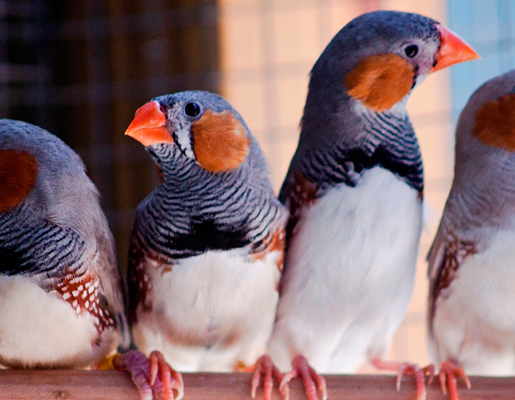The missing birds
Study documents effects of mercury on songbird reproduction
Mercury takes a toll on the population of songbirds, even at sublethal doses.
Research conducted on captive birds at William & Mary showed that reproductive success went down as the dosage of mercury increased. The results, published in the peer-reviewed journal PLOS One, have serious implications for wild birds living in areas contaminated by mercury pollution.
In the context of the study, “reproductive success” was achieved when a chick became mature enough to be independent of its parents. The researchers also compared effects in birds that receive mercury over their lifetime to birds that were dosed only during adulthood. Among the results was a surprise: evidence that the offspring of some of the most heavily dosed birds demonstrated higher tolerance to the effects of mercury than their parents’ generation.
 Claire W. Varian-Ramos, the lead author on the paper, conducted the research while a post-doctoral researcher at William & Mary. She now is on the faculty of Colorado State University-Pueblo. Other authors are Dan Cristol and John Swaddle, both professors in William & Mary’s Department of Biology. The researchers note that their study is the first experimental documentation of mercury’s effect on songbird reproduction.
Claire W. Varian-Ramos, the lead author on the paper, conducted the research while a post-doctoral researcher at William & Mary. She now is on the faculty of Colorado State University-Pueblo. Other authors are Dan Cristol and John Swaddle, both professors in William & Mary’s Department of Biology. The researchers note that their study is the first experimental documentation of mercury’s effect on songbird reproduction.
Lab validation of field observations
The controlled studies are funded by E.I. DuPont de Nemours and Co. They provide laboratory context for years of field observations, mainly in the Shenandoah valley. Cristol has studied birds and their prey around a site near Waynesboro that was contaminated by industrial mercury. Bacteria in soil and water process the mercury, converting it to toxic methylmercury, which bioaccumulates as it rises through the food chain. The Shenandoah studies found birds were getting mercury through their food, chiefly insects and spiders.
“We found in the field that there is pretty good evidence that these birds are at risk, but there hasn’t been any experimental dosing study done on these birds to confirm the effects seen in the field,” Varian-Ramos explained.
The scientists exposed groups of zebra finches to one of four levels of mercury in their food: .3, .6, 1.2 and 2.4 parts per million.
“Each level, except for the highest one, corresponds to mercury levels present in the wild,” Cristol said. “The highest level is the worst you can imagine occurring, and I don’t know if anyone’s found that place yet.”
Less mercury than a can of tuna
Even birds receiving the lowest level of mercury—.3 parts per million—suffered a 15 percent decline in reproductive success.
“Just for a frame of reference, the can of tuna you buy at the grocery store has about .5 parts per million,” Varian-Ramos said. “It’s similar to what you might find in bird prey items on many contaminated sites.”
Other groups of birds were dosed at .6, 1.2 and 2.4 parts per million and the reproductive success rate dropped accordingly. Birds receiving the highest dose, 2.4 ppm, saw a 50 percent drop in reproductive rate.
The mercury had no effect on the number of eggs laid or the hatch rate, but the birds with mercury-dosed parents fledged—becoming able to act independent of their parents—at lower rates than control birds. Varian-Ramos points out that the lower fledging rate is in line with other research showing that mercury has a greater impact on developing nervous systems than on adults. Accordingly, the birds that had lifetime exposure to mercury showed a greater sensitivity to the medium doses of mercury than the adult-exposure group
“That’s been shown to be true in a lot of species—including humans,” she said. “When you’re talking about human health, the impact of mercury is much greater in the developing fetus and on young children than on adults.”
Artificial selection at work
The researchers’ surprise came in the examination of the reproductive rate of the offspring of birds that had received the highest level of mercury. Cristol pointed out that these birds, survivors of a group that suffered a 50 percent loss, showed an unexpectedly better reproduction rate than did their parents.
“It looks like we’ve artificially selected for mercury resistance in a single generation,” Cristol said, the same process that drives evolution of antibiotic resistance in microbes and pesticide resistance in bugs.”
He added that the surviving birds may have inherited a mechanism for moving the methylmercury out of their body, excreting it or processing it through their feathers. It’s also possible that the birds are binding the mercury in their internal organs.
The researchers are worried that their results might be misinterpreted and used to make a case that mercury contamination isn’t particularly harmful to songbirds. Cristol stressed that the mercury-tolerant group of birds were part of a controlled experiment and, apart from the mercury, don’t face the challenges of wild birds have. In addition to the effects on the fledging rate of their offspring, the mercury affected the adult birds as well. There is evidence that mercury degrades a bird’s ability to avoid predators and even its capability for finding food.
The birds look just fine, but…
Cristol said that the birds rarely showed any signs of distress to a casual observer. For example, Cristol said the birds that received the 1.2 pmm dose look perfectly healthy and still managed to produce 70 percent of the babies that they would if they weren’t on mercury.
“But that’s in captivity,” he stressed. “All they have to do is get their food and and fly across the cage to their baby.”
He said the same birds were placed in a room sized arena and tasked with recalling which of ten different feeders were loaded with food, the mercury-dosed birds couldn’t remember for the space of an hour. He said the control birds flew to the right feeder two days later.
“If you put those birds out in the wild, with a memory so impaired that they can’t remember anything for an hour about spatial locations, they would never survive,” he said. “And yet in the cage, we’re just seeing a 30 percent decline in reproduction.” ![]()















